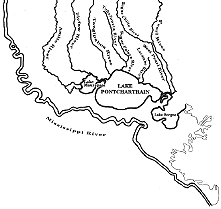
|
The functions and values of wetlands
are of paramount importance to us all and
their contribution to society is enormous.
Let's take a closer look:

Click the illustration for a larger view.
Wetland Functions & Values in Louisiana*
( the following sections is based on Wetland Functions & Values in Louisiana. Pub. 2519, LA Cooperative Extension Service. 9/94)

Commercial Values:
Commercial fishing has a direct dockside value of almost $4 billion in the U.S. More than 70% of that value consists of species that spend part of their life cycle in coastal wetland estuaries. Louisiana's coastal wetlands serve as a valuable nursery area for shrimp, oysters, menhaden ("pogey"), blue crabs,and many finfish species. This harvest is a vital part of Louisiana's economy, providing millions of dollars and thousands of jobs each year.
Alligators, once endangered in many parts of their local range, are a success story to proper wildlife management. More than 25,000 wild alligators are taken from Louisiana's wetlands each year for their hides and meat.
Furbearing animals such as nutria, mink, raccoon, otter, muskrat, bobcat, and beaver are found in great abundance in Louisiana's wetlands. About 40% of the nation's wild fur harvest comes from here. A strong fur market is a logical, valuable solution to the problem of nutria "eat-outs" in marshes of the Lake Pontchartrain Basin and the resultant wetland loss. It would provide an effective means of producing income for trappers while reducing the extensive damage to wetland vegetation caused by these members of the rodent family.
Oil and natural gas production are vitally linked to Louisiana's wetlands, providing jobs for residents and revenue for government services. This has a total value exceeding $550 million annually. Important products, like sand and gravel, are also mined from coastal wetlands. An important question for the future will be how to continue to reap the benefits of these industries while reducing damage to the environment.
Forestry is another important value of wetland areas. Forested wetlands make up more than 82 million acres of forests in the U.S. Timber production in southern wetland forests has an annual value of over $10 billion. Properly managed, this vital resource will continue to provide both income and jobs for the future. If not managed, the resource can be lost. Beautiful old-growth cypress swamps once existed in the LaBranche Wetlands and in the Manchac Wildlife Management Area, but those regions were heavily logged, and their extensive cypress forests are gone.
Recreational Values:

More than 330,000 hunting licenses and 900,000 fishing licenses are sold every year in Louisiana to sportsmen and women. Those hobbies are closely related to wetlands-dependent species of ducks, geese, and fish, but their economic value exceeds the cost of buying a license alone. Purchases such as gasoline, bait, tackle, ammunition, food, boat launch fees, hunting leases, and other items result in a combined commercial value of over $1 billion.
The swamps, bayous, and marshes of Louisiana represent a cultural value as the home of many Louisiana residents who have a strong dependence on the wetlands for their food and livelihood. This culture is unique to Louisiana and is intertwined with other recreational and commercial values of the wetlands.
Cultural Values:
People enjoy wetlands for a variety of reasons, and Louisiana's wetlands constitute a world-renowned ecological resource attraction. Some of the activities that bring visitors to our wetlands are boating, swimming, camping, water-skiing, hiking, birding, photography, journaling, and painting.
Wildlife Habitat:

Wetlands produce enormous amounts of organic material and detritus, which is directly linked with wildlife and fisheries productivity. This makes wetlands two to three times more productive than very fertile agricultural land. The abundant vegetation found in wetland areas supplies food and shelter to the many organisms found in that ecosystem.
Wetlands are known for their incredible biodiversity. Hundreds of non-game mammals, fish, birds, reptiles and amphibians, as well as over 50 wild game and fish species, inhabit wetland areas. Currently though, 79 species of animals and plants found in U.S. wetlands are on the threatened or endangered species list due to wetland loss. Over 100 other species are nearing that distinction. In the Lake Pontchartrain Basin, the Louisiana Black Bear has almost disappeared from its range, while the American alligator and the brown pelican have made dramatic comebacks.
Water Quality:
One of the most valuable functions of wetlands is their ability to filter sediments, nutrients, and chemical pollutants from the water which flows from land. Wetland plants are able to remove nitrogen and phosphorus from runoff water, especially near agricultural areas. Other wetland plants help remove heavy metals, sewage, and pesticides, thus preventing them from doing further damage in the ecosystem. These pollutants are also removed in healthy wetlands through chemical processes that occur in water and soil.
Wetlands act both as a sink and as a conduit for water. Percolation of water through soil recharges aquifers which are important sources of drinking water and industrial uses in some communities. Fresh water that flows from wetlands helps support plant and animal life during droughts and can help reduce effects of saltwater intrusion.
Storm Buffer Zone:
When tropical storms or hurricanes batter the shoreline along the Gulf of Mexico, coastal wetlands absorb the force of the wind and waves, thus protecting homes and property from excessive damage. Wetlands also hold large quantities of water that would otherwise flood residential or agricultural areas. This important function of wetlands is valued at billions of dollars.
Erosion and Flood Control:
Vegetated wetlands provide protection against erosion along banks and shorelines of bodies of water. Natural wetland loss and development contribute to shoreline erosion problems, which exceed 100 feet per year in some areas. Wetlands restoration projects are helping to slow that process, but they are costly and time-consuming. If 15% of a watershed consists of wetlands, flooding peaks can be reduced by approximately 60%. That's because wetlands, as a natural sink, hold flood waters or slow them down.
Draining and filling natural backwater areas often causes increased flood problems for nearby developed areas. In the U.S., annual losses due to flood damage amount to more than $3 billion in property damage and almost 200 human lives.
Education and Research:
Whether as an outdoor classroom for school children or as a field study site for scientific research, wetlands are unparalleled for their educational value. They are ideal places for students of any age to explore the interrelationships among various factors in an ecosystem, as well as to understand the ecological, economic, social, and legal complexities of an important environmental issue.
|






